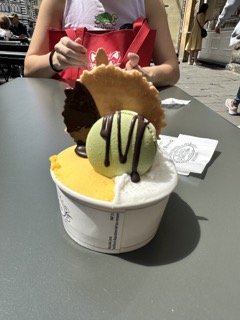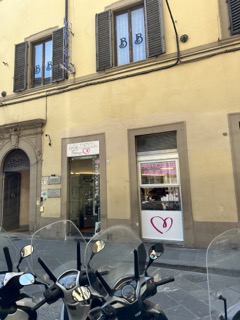Gelato isn't always Gelato: How to Spot an Authentic Cup
- Gabrielle Keller

- May 24, 2023
- 7 min read

What is Gelato?
You are having your hot Italian summer. Your linen pants are flowing elegantly in the breeze as you walk down the street. The sweet smell of butter and sugar lingers in your nostrils and makes your head turn. The pleasant aroma is coming from a cute little gelateria on the side of the street. In addition to the scent of the waffle cones, the bright-colored decorations and inviting atmosphere entices you to walk into the store. You take a peek behind the glass container and see so many different colors of the creamiest-looking dessert. You order a scoop, leave the shop, and continue your way down the cobblestone street. As the gelato starts dripping off of the cone and onto your hand, you lick it and think, “This is exactly how I imagined Italy.”
Gelato is perhaps the most well-known Italian dessert. Everyone loves it, and it is a staple food item when you visit Italy. Some people even have gelato every day. Cosimo Ruggeri is credited to have invented the dairy-based dessert in a competition for Catherine de’ Meddici during the 16th century.
In Italian, the word “gelato” means all kinds of ice cream. The beloved dessert is made similar to ice cream by using milk, sugar, cream, and various flavoring ingredients such as nut pastes. However, there are distinct differences between American ice cream and traditional Italian gelato. Italian gelato is churned at a much slower speed than ice cream, creating a smoother consistency as it contains much less air. Surprisingly, gelato contains much less fat than regular ice cream, even though it has a much smoother texture. It only has around 6-8% butterfat, as it is made with more milk than cream. The final product is rich, creamy, and vibrant with flavor. That is why so many people love it!
“It is the smoothest frozen dessert,” says Giulia Esposito, an employee of a highly regarded gelato shop called Carabé, “there is nothing like it.”
Though Italy has regulations on making gelato, the majority of gelaterias do not serve traditional gelato. All of it tastes good, but if you want to try the good stuff, you have to know where to look.
“Most places on the street just want tourists’ money,” says Esposito, “don’t go to those places.”
Don’t Judge a Book by its Cover
Gelato looks different in every storefront you go to. Sometimes, you will see large piles of bright-colored gelato with candy covering the top. The gelato in these displays are usually is in plastic bins. This is the stuff you see most often; it’s enticing and delicious. Sometimes, the dessert is hidden, and you can’t even tell what it looks like.

Piles of gelato in displays indicate that this gelato contains a lot of additives, extra fat, and emulsifiers to give it height. It also probably indicates it is churned quicker, which means it has more air and less creamy consistency. Additionally, these desserts are often in plastic containers, which indicates that it is mass-produced in a factory. It may still taste delicious, but it will be harder to notice the difference between the “gelato” you are eating and traditional ice cream.
“The mounds are good if I am just craving something sweet. But if want gelato, I only go to the best places,” says Elisa Mancini, a Florence local and gelato enthusiast.
If you want the good stuff, you have to search a little deeper. Don’t be fooled; the low-quality gelaterias are trying to compete with artisanal gelaterias by storing their candy-covered mountains in metal containers. Traditional gelato is tightly packed in a metal container and is stored lower than the counter. Gelato needs to be stored at a colder temperature than traditional ice cream, as the lower percentage of fat makes it easier to melt. Even more indicative of top-notch quality gelato is metal lids that completely cover the gelato from public view. This is a surefire way of knowing they have the good stuff. It is all about the temperature! Covered tins are the best way to keep the dessert cold, and it also means that the gelato needs no advertising display. The product alone should speak for itself!
Inside the tins
Authentic Italian gelato should have a very specific appearance. Though a lot of quality product is typically covered and hidden from public view, uncovered gelato doesn’t mean it is unauthentic. Look out for a few key characteristics in uncovered gelato flavors that indicate their quality.

The first key characteristic is the color of the gelato. If the colors are unnaturally bright, it probably means it is full of food coloring. The telltale sign of bad gelato is by looking at the pistachio flavor. Pistachio is the most popular flavor in Italy, so every store has it. If the pistachio flavor is a bright green, the gelato is not authentic. Pistachio should look like a very dull green-brown color. Another important flavor is lemon, and it is easy to spot the good quality version. Instead of a bright neon yellow color, authentic lemon gelato should be white. For fruit flavors, look for deep muted berry colors rather than bright pinks, and purples. For non-fruity flavors, look for pale or subdued colors. These natural-looking colors indicate that the gelato is being used with natural ingredients. Authentic gelato is meant to be used with only the most simple products. You want your gelato to look like it is coming from the Earth!
“Our colors are pale,” says Esposito, “we only add flavoring ingredients. We don’t add anything to make the gelato look a certain way.”

Though it may look more appealing, gelato should not be shiny. If it is, it may indicate the use of too much sugar, or the gelato is oxidized. If it is oxidized, it means that the gelato is stored at fluctuating temperatures. The dessert will melt, and then refreeze. Not only does this indicate old gelato, but it also means that its crystalline structure will be destroyed. Instead of being the thick, creamy texture it was intended on being, the gelato may be more icy and less structurally sound.
You may think that the more flavors the gelato shop has, the better. That isn’t necessarily true. There is a core group of flavors that usually every authentic gelateria will have: pistachio, strawberry, chocolate, stracciatella, hazelnut, fiordilatte, coffee, lemon, and coconut. Other popular flavors include Mango, tiramisu, vanilla, and dark chocolate. If the gelateria has interesting choices beyond that, they should only be natural flavors that are made from local, in-season ingredients. If you see fruit flavors, make sure it is the correct season for the fruit. Otherwise, you will know it isn’t fresh-made gelato. For example, the peach flavor should only be available during the summer. The more crazy flavors the gelateria has, such as cookie monster or Rainbow, it probably means you are eating mass-produced gelato.
It is also important to notice how the gelato is being served. The tools used to scoop the gelato can tell you a lot about the consistency of the product, as well as the quality of it. Traditionally, gelato is scooped with a metal spade and pushed carefully on the cone. As the gelato is scraped onto the cone, it will look like stretchy ribbons as the spade spreads it to form creamy-looking mounds. If the gelato is scooped with a traditional ice cream scooper and plopped onto the cone, it is not authentic. Gelato should be far too creamy and sticky to use an ice cream scoop. So, if you pass a gelateria that uses them, you will not be getting that coveted consistency that you are craving.
Flashy Store Fronts

The best gelaterias are lowkey, and build a customer base solely on their product. They don’t need a flashing bright ice cream cone sign to attract people, the word will always spread if it’s good! So, check out the smaller, easier-to-miss gelaterias. You might be surprised to find out that it is the best gelato you have ever had! Oftentimes in Italy, you will see a storefront with a small printed “gelateria” sign with a long line coming out of it. You may even wonder, “What could worth be lining down the block for gelato, you can get it anywhere?” There is a reason people line up for the dessert, and the line might just be worth the wait!

If the gelateria specifically says gelato in casa, fatto in casa, or gelato artigianale, it is probably authentic. These words all mean the gelato was made in-house, homemade, or artisanal. Theoretically, this should be a telltale sign of good gelato but some shops falsely advertise it, so be careful!
You can’t go wrong!
Even though there is a huge distinction between real gelato and the copycat version, they all taste pretty good! However, if you are in Italy, you need to know where to find the real deal. Hopefully, soon, it will be much easier to get the good stuff, as Italy may even establish stricter regulations on gelato.
“There are a bunch of rules about selling wine in Italy. I think it would make sense to make more rules for gelato too. It will be good for tourists because they go to Italy to try gelato, so they should know what they are getting when they do,” says Mancini.

Your hot Italian summer is not complete without gelato. An authentic cup will give you instant gratification. The wind continues to blow through your linen pants as you scrape up the last of the melty liquid at the bottom of the cup. After you throw the container out and wipe the sticky residue off of your hands, you will feel more connected to and knowledgeable about Italian culture.





















Comments